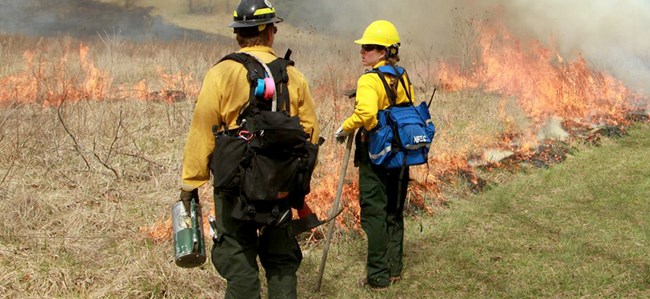- Duration:
- 4 minutes, 42 seconds
Wildland fire modules play an important role in preparing for fire in national parks.

NPS
Wildland fire management is inherently risky, so planning and preparation are important aspects of the program.
Fire managers go through a continual process each year to be ready to respond as necessary. The process includes developing plans, maintaining equipment, predicting fire activity, preventing human-caused fires, hiring, training, equipping, and dispatching firefighters, evaluating performance, correcting areas in need of improvement, and improving overall operations.
This "preparedness" process includes routine activities before fire season begins, as well as step-by-step actions in response to increasing fire danger as the season progresses.

NPS
Personnel
Fire management staff in a park where fires frequently occur are vital to adequate response. In smaller parks, where wildfire may be an infrequent visitor, rangers or other park staff may also work as collateral duty firefighters - in addition to their normal job - and respond as the need arises. A park biologist, office assistant, historian, or other professional may chose to serve as a collateral duty firefighter."
Working with wildland fire takes lots of people. Engine crews, hand crews, and helicopter crews are some of the resources that work with fire. And there are lots of people who support the crews working on fires: fire ecologists, planners, timekeepers, and warehouse staff. It takes a team for wildland fire!
Training
Preparation includes lots of training. Fire work can be dangerous and people need to be properly prepared to work under hazardous conditions. And again, those supporting fire management also need to be trained in order to offer their support.
Fire Management Plans
Wildland fire work takes planning. You need to know how to respond and where to work effectively before the response is needed. We focus our planning on park lands, and sometimes, even our neighbors. Collaboration is the key to successful wildland fire management.

NPS/W. BIELENBERG
Equipment
Engines, helicopters, and airplanes are some of the big tools we use, but the firefighter on the ground gets the work done each and every day with smaller equipment. They need helmets, flame resistant clothing, gloves, fire shelters, saws, and handtools to do their work.
Fuels Reduction
Fuels reduction work begins with vegetation cutting and removal. Just as you might mow your lawn and prune your backyard bushes, firefighters take similar steps to protect backcountry cabins, visitor centers, and campgrounds.
Prescribed fire is another way the national parks are able to remove vegetation and lessen the risk of unwanted wildfire.
Preparedness Levels
Fire managers track current and expected workload by looking at the number of fires, people and equipment currently and expected to be assigned to fire. Preparedness levels are a good way to track what work we expect to do in the near future. Fire managers want to be able to have the people and equipment available for fire response and prescribed burning. Preparedness levels help fire managers plan and determine whether they’ll have the people and equipment they need.
Preparing for Fire
-
 Wildland FireFire Season
Wildland FireFire SeasonKeep up to date with the fire season situation, both nationally and locally, through incident reports and the national situation report.
-
 Wildland FireWildland-Urban Interface
Wildland FireWildland-Urban InterfaceInformational material that discusses how the wildland urban interface (WUI) came about and what can be done near national parks.
Last updated: October 6, 2019
